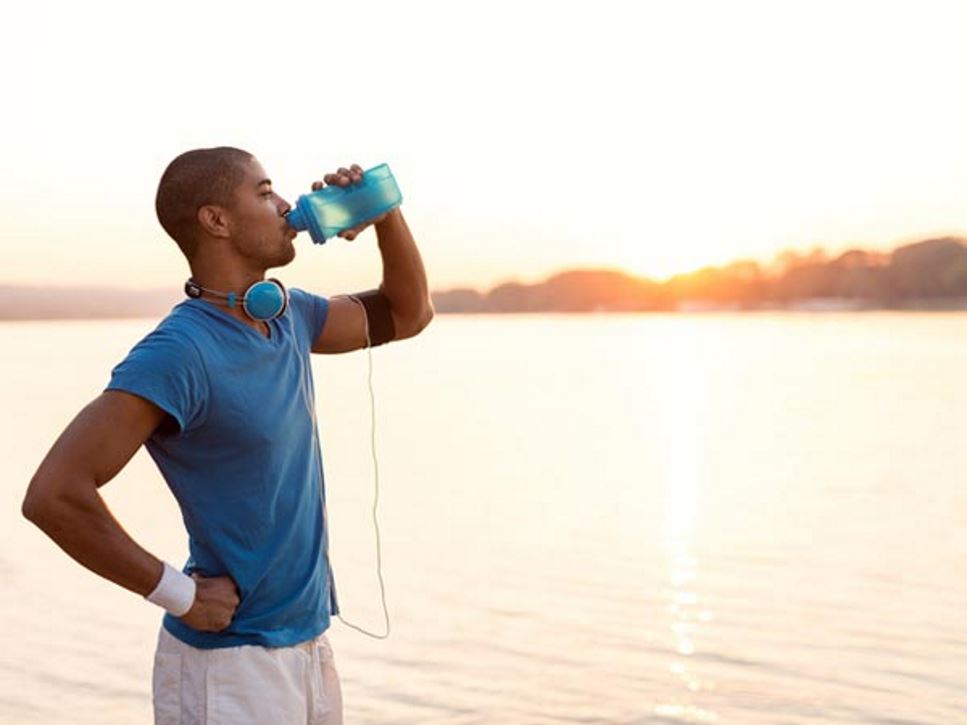Proper hydration is important to normal body function as well as healthy physical activity. Drinking the right amount of fluid before, during and after physical activity is vital to providing your body the fluid it needs to perform properly. Sports dietitians assist athletes by developing individualized hydration plans that enhance performance in training and competition while minimizing risks for dehydration, over-hydration and heat illness and injury.
Hydration Goals
The overall goal is to minimize dehydration without over-drinking. Adequate hydration varies among individuals. Practical ways to monitor hydration are:
- Urine color. The color of the first morning's urine void after waking is an overall indicator of hydration status. Light colored urine is a sign of appropriate hydration. Darker colored urine, the color of apple juice, generally indicates inadequate fluids are being consumed throughout the day.
- Sweat loss. Change in body weight before and after exercise is used to estimate sweat loss. Since an athlete's sweat loss during exercise is an indicator of hydration status, athletes are advised to follow customized fluid replacement plans that consider thirst, urine color, fluid intake, sweat loss and body weight changes that occur during exercise.
Minimize Dehydration
Dehydration can occur during any type of physical activity or in any type of weather. It doesn't have to be hot. You don't have to visibly sweat. You can become dehydrated in the water, at a pool or lake, or skiing on a winter day.
Dehydration results when athletes fail to adequately replace fluid lost through sweating. Since dehydration that exceeds 2% body weight loss harms exercise performance, athletes are advised to begin exercise well hydrated and to minimize dehydration by replacing fluids during and after exercise.
Be alert for conditions that increase your fluid loss through sweat.
- Air Temperature: The higher the temperature, the greater your sweat losses.
- Intensity: The harder you work out, the more you perspire.
- Body Size and Gender: Larger people sweat more. Men generally sweat more than women.
- Duration: The longer the workout, the greater the fluid loss.
- Fitness: Well-trained athletes perspire more than less fit people. Why? Athletes cool their bodies through sweat more efficiently than most people because their bodies are used to the extra stress. Thus, fluid needs are higher for highly trained athletes than for less fit individuals.
Remember swimmers sweat, too. Like any athletic activity, when you swim, your body temperature rises and your body sweats to keep from overheating. You may not notice because you are in the water, but you can become dehydrated. Swimmers, from competitive athletes to families splashing around, need to drink fluids before, during and after swimming, even if you don't feel thirsty.
Signs You May Be Dehydrated
Know the signs of dehydration. Signs may include:
- Intense thirst
- Exhaustion or increased perception of effort
- Increased body temperature
- Faster breathing and pulse rate
- Confusion
- Fainting
Fluid Replacement
Replace fluids during exercise to promote adequate hydration. Drink water rather than pouring it over your head. Drinking is the only way to rehydrate and cool your body from the inside out. Sports drinks are more appropriate than water for athletes engaged in moderate- to high-intensity exercise that lasts longer than an hour. Rehydrate after exercise by drinking enough fluid to replace fluid losses during exercise.
References
Find a Nutrition Expert
Looking for credible nutrition information and recommendations? The Academy of Nutrition and Dietetics' network of credentialed food and nutrition practitioners are ready to help!

